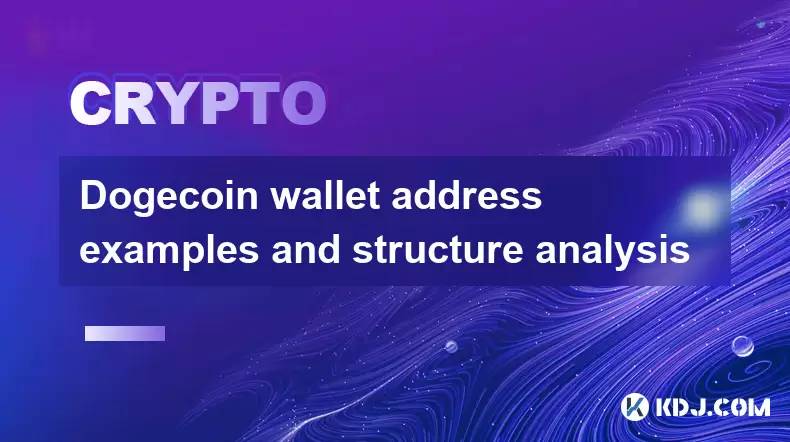-
 Bitcoin
Bitcoin $114400
0.68% -
 Ethereum
Ethereum $3550
2.48% -
 XRP
XRP $3.001
4.99% -
 Tether USDt
Tether USDt $0.9999
0.01% -
 BNB
BNB $757.6
1.46% -
 Solana
Solana $162.9
1.07% -
 USDC
USDC $0.9998
0.00% -
 TRON
TRON $0.3294
0.91% -
 Dogecoin
Dogecoin $0.2015
2.46% -
 Cardano
Cardano $0.7379
2.01% -
 Stellar
Stellar $0.4141
8.83% -
 Hyperliquid
Hyperliquid $37.83
-1.91% -
 Sui
Sui $3.454
0.76% -
 Chainlink
Chainlink $16.62
3.53% -
 Bitcoin Cash
Bitcoin Cash $554.6
2.84% -
 Hedera
Hedera $0.2486
3.91% -
 Ethena USDe
Ethena USDe $1.001
0.00% -
 Avalanche
Avalanche $21.95
3.34% -
 Toncoin
Toncoin $3.563
-2.85% -
 Litecoin
Litecoin $112.7
2.65% -
 UNUS SED LEO
UNUS SED LEO $8.977
0.13% -
 Shiba Inu
Shiba Inu $0.00001232
1.85% -
 Uniswap
Uniswap $9.319
2.93% -
 Polkadot
Polkadot $3.632
1.38% -
 Monero
Monero $307.2
2.36% -
 Dai
Dai $0.9997
-0.03% -
 Bitget Token
Bitget Token $4.340
0.91% -
 Pepe
Pepe $0.00001048
1.07% -
 Cronos
Cronos $0.1348
3.26% -
 Aave
Aave $261.5
1.93%
Dogecoin wallet address examples and structure analysis
A Dogecoin wallet address, starting with "D," is a unique identifier for secure blockchain transactions, generated through cryptographic hashing and encoded in Base58Check to prevent errors.
Jun 13, 2025 at 09:42 pm

Understanding Dogecoin Wallet Addresses
A Dogecoin wallet address serves as a unique identifier for receiving and sending DOGE. It functions similarly to a bank account number but is designed specifically for blockchain transactions. Each address consists of a combination of letters and numbers, typically starting with the letter "D". These addresses are derived from public keys using cryptographic algorithms, ensuring that each one is unique and secure.
The structure of a Dogecoin wallet address adheres to specific encoding standards. Most commonly, they follow the Base58Check format, which eliminates certain characters (like 0, O, I, l) to reduce confusion during manual entry or scanning. This encoding also includes a checksum to detect and prevent errors in transaction inputs.
Example of a Dogecoin wallet address:
D8B6zQYj9qQQgLEfV1KWSX7E4jPc9iqwJnComponents of a Dogecoin Address
Each Dogecoin wallet address contains several critical components:
- Version Byte: The initial byte indicates the type of address. For standard Dogecoin addresses, this value is usually
0x1ein hexadecimal, which translates to the letter "D" when encoded in Base58. - Public Key Hash: Derived from the user’s public key through a series of hashing operations (typically SHA-256 followed by RIPEMD-160), this portion ensures uniqueness and security.
- Checksum: A four-byte hash used to verify the integrity of the address. It's generated by applying SHA-256 twice to the version byte and public key hash and taking the first four bytes of the result.
Together, these elements form a robust system that prevents common errors like mistyped addresses during transactions.
How Dogecoin Addresses Are Generated
Creating a Dogecoin wallet address involves multiple steps:
- Private Key Generation: A random 256-bit number is created, serving as the foundation of the wallet. This key must remain secret at all times.
- Public Key Derivation: Using elliptic curve multiplication, the private key generates a corresponding public key.
- Hashing Process: The public key undergoes SHA-256 and RIPEMD-160 hashing to produce a shorter, more manageable identifier.
- Encoding: The final step combines the version byte, hashed public key, and checksum before applying Base58 encoding to generate the human-readable address.
This process ensures that even minor changes in input yield entirely different outputs, making brute-force attacks impractical.
Different Types of Dogecoin Addresses
While most Dogecoin addresses begin with "D", there are variations based on network upgrades and wallet configurations:
- Legacy Addresses (Pay-to-PubKey-Hash): These traditional addresses start with "D" and are compatible with nearly all wallets and exchanges.
- Bech32 Addresses: Introduced with Segregated Witness (SegWit), these addresses start with "bc1" but are not commonly used in Dogecoin due to limited adoption.
- Multi-Signature Addresses: Require multiple private keys to authorize a transaction, offering enhanced security for shared wallets or organizations.
Each type offers distinct advantages depending on use cases such as speed, cost-efficiency, or security requirements.
Validating a Dogecoin Wallet Address
Before sending funds, verifying the correctness of a Dogecoin address is crucial. Several methods exist for validation:
- Manual Inspection: Ensure the address starts with "D" and has no visually ambiguous characters like "0" and "O".
- Checksum Verification: Software tools automatically decode the address and recalculate the checksum to confirm validity.
- QR Code Scanning: Many wallets allow users to scan QR codes containing addresses, minimizing typing errors.
Using online validation tools or built-in wallet checks significantly reduces the risk of irreversible mistakes.
Frequently Asked Questions
Can I reuse a Dogecoin wallet address?
Yes, you can technically reuse an address, but it is considered best practice to generate a new one for each transaction to enhance privacy and security.
What happens if I send DOGE to an invalid address?
If an address fails the checksum verification, most wallets will reject the transaction attempt. However, if sent incorrectly, recovery may be impossible unless the recipient controls the destination wallet.
Are Bech32 Dogecoin addresses widely supported?
Currently, support for Bech32 addresses remains limited within the Dogecoin ecosystem compared to legacy formats. Most exchanges and wallets still primarily use the older "D"-prefixed addresses.
How do I check the balance of a Dogecoin wallet address?
You can use a blockchain explorer like blockchair.com or blockcypher.com by entering the address into the search bar. This will display the current balance and transaction history associated with that wallet.
Disclaimer:info@kdj.com
The information provided is not trading advice. kdj.com does not assume any responsibility for any investments made based on the information provided in this article. Cryptocurrencies are highly volatile and it is highly recommended that you invest with caution after thorough research!
If you believe that the content used on this website infringes your copyright, please contact us immediately (info@kdj.com) and we will delete it promptly.
- Cryptocurrency, Altcoins, and Profit Potential: Navigating the Wild West
- 2025-08-04 14:50:11
- Blue Gold & Crypto: Investing Disruption in Precious Metals
- 2025-08-04 14:30:11
- Japan, Metaplanet, and Bitcoin Acquisition: A New Era of Corporate Treasury?
- 2025-08-04 14:30:11
- Coinbase's Buy Rating & Bitcoin's Bold Future: A Canaccord Genuity Perspective
- 2025-08-04 14:50:11
- Coinbase's Buy Rating Maintained by Rosenblatt Securities: A Deep Dive
- 2025-08-04 14:55:11
- Cryptos, Strategic Choices, High Returns: Navigating the Meme Coin Mania
- 2025-08-04 14:55:11
Related knowledge

Bitcoincoin burning mechanism
Jul 20,2025 at 09:21pm
What is the Dogecoin burning mechanism?The Dogecoin burning mechanism refers to the process of permanently removing DOGE tokens from circulation by se...

How to earn free Bitcoincoin?
Jul 19,2025 at 10:08pm
What is Dogecoin and Why Earn It?Dogecoin (DOGE) started as a meme-based cryptocurrency in 2013 but has grown into a widely recognized digital asset. ...

Is Coinbase a good wallet for Bitcoincoin?
Jul 19,2025 at 04:42pm
Understanding Coinbase as a Wallet Option for DogecoinWhen considering where to store Dogecoin, Coinbase is often mentioned as a potential option due ...

How to buy Bitcoincoin with PayPal?
Jul 23,2025 at 06:57am
Understanding the Basics of Buying DogecoinBefore diving into the process of buying Dogecoin with PayPal, it’s essential to understand what Dogecoin i...

Best app to buy Dogecoin
Jul 23,2025 at 03:08pm
What Is a Cryptocurrency Exchange and How Does It Work?A cryptocurrency exchange is a digital marketplace where users can buy, sell, or trade cryptocu...

How are Dogecoin gains taxed?
Jul 25,2025 at 07:01am
Understanding the Taxation of Dogecoin GainsWhen it comes to Dogecoin (DOGE), many investors are drawn to its meme-inspired branding and volatile pric...

Bitcoincoin burning mechanism
Jul 20,2025 at 09:21pm
What is the Dogecoin burning mechanism?The Dogecoin burning mechanism refers to the process of permanently removing DOGE tokens from circulation by se...

How to earn free Bitcoincoin?
Jul 19,2025 at 10:08pm
What is Dogecoin and Why Earn It?Dogecoin (DOGE) started as a meme-based cryptocurrency in 2013 but has grown into a widely recognized digital asset. ...

Is Coinbase a good wallet for Bitcoincoin?
Jul 19,2025 at 04:42pm
Understanding Coinbase as a Wallet Option for DogecoinWhen considering where to store Dogecoin, Coinbase is often mentioned as a potential option due ...

How to buy Bitcoincoin with PayPal?
Jul 23,2025 at 06:57am
Understanding the Basics of Buying DogecoinBefore diving into the process of buying Dogecoin with PayPal, it’s essential to understand what Dogecoin i...

Best app to buy Dogecoin
Jul 23,2025 at 03:08pm
What Is a Cryptocurrency Exchange and How Does It Work?A cryptocurrency exchange is a digital marketplace where users can buy, sell, or trade cryptocu...

How are Dogecoin gains taxed?
Jul 25,2025 at 07:01am
Understanding the Taxation of Dogecoin GainsWhen it comes to Dogecoin (DOGE), many investors are drawn to its meme-inspired branding and volatile pric...
See all articles

























































































